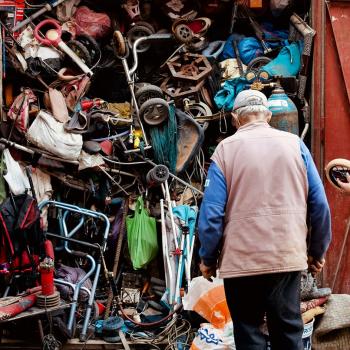Cities like Grants Pass, Oregon are making unsheltered homelessness illegal. But here are six reasons why shelters won’t solve the problem.

In my last article, “6 Things You Can Do at Home That are Illegal if You’re Homeless,” I discuss the Supreme Court case, Grants Pass versus Johnson. That city has targeted public camping, among other behaviors of unsheltered individuals, in an attempt to criminalize homelessness itself. In a New York Times interview, Abbie VanSickle, correspondent to the Supreme Court says:
The issue actually started years ago with a case about 500 miles to the East, in Boise, Idaho. And in that case, which is called Martin v. Boise, this man, Robert Martin, who is homeless in Boise, he was charged with a misdemeanor for sleeping in some bushes. And the city of Boise had laws on the books to prohibit public camping.
And Robert Martin and a group of other people who are homeless in the city, they sued the city. And they claimed that the city’s laws violated the Eighth Amendment’s prohibition on cruel and unusual punishment…
…Their argument was that the city did not have enough sufficient shelter beds for everyone who was homeless in the city. And so they were forced to sleep outside. They said, we have no place to go and that an essential human need is to sleep and we want to be able to lay down on the sidewalk or in an alley or someplace to rest and that their local laws were a violation of Robert Martin and the others’ constitutional rights, that the city is violating the Eighth Amendment by criminalizing the human need to sleep.
And the courts who heard the case agreed with that argument. The courts ruled that the city had violated the Constitution and that the city could not punish people for being involuntarily homeless. And what that meant, the court laid out, is that someone is involuntarily homeless if a city does not have enough adequate shelter beds for the number of people who are homeless in the city.
Shelter Won’t Solve the Problem
So, for Boise, it would seem that the solution would be to provide enough shelter space for all the unsheltered people. That way, there would be no involuntary homelessness. The problem is that this assumes that shelters solve the problem for every homeless individual. Don’t get me wrong—I work full-time in Washington State with people experiencing homelessness, and see the amazing work done by shelter staff. I also volunteer when I can at the shelter in the town where I live in British Columbia. In both locations, shelters are a fantastic resource. But they won’t solve the problem of homelessness either in the US or Canada.
Why Can’t They Just Go to the Shelters?
Those who support criminalizing behaviors common to the houseless population say, “We’re not against homeless people—we just find such activities unacceptable in public. They should go to the shelters.” This argument ignores the fact that some of these behaviors (sexual activity, for example) would still be illegal in shelters. It also overlooks the many good reasons why some people wouldn’t be caught dead in a shelter:
- Enemies. Some people have enemies in the shelters. Avoiding shelters means avoiding fights.
- Mental illness. Others suffer from agoraphobia, schizophrenia, PTSD, depression, anxiety, and other disorders that may be exacerbated by living in the crowded conditions of a shelter.
- Physical health. Still others live with immune deficiencies that present a physical hazard if they live in an aggregate setting.
- Animals. Some have pets that serve as emotional support animals or service animals yet lack the proper documentation. They would rather not go to shelters than abandon these beloved animals.
- Legal reasons. Undocumented immigrants, people with warrants for their arrest, and others with legal concerns often avoid shelters out of concern that they might be detained if discovered.
- Overcrowding. There simply isn’t enough room for everyone at the shelters. In the city where I work, lines form at 5:00 for the 7:00 evening check-in. If there are no beds, you’re out of luck. And “if there isn’t a bed, you don’t get fed.” Better luck next time—try again tomorrow.
For these reasons and more, many unhoused individuals choose to live outside of the shelters. This might be in group encampments, single-tent camps, or under a bridge or doorway. If every unhoused person suddenly went to the shelters, they would overwhelm the system. Communities like Grants Pass enforce harsh laws against people without homes because they would rather not invest the resources to care for them. It’s easier to make your city inhospitable to them and force them to move along.
“Not in My Backyard”
This “not in my backyard” attitude means communities are forcing unsheltered people into transience. According to OBP, Lily Morgan, the council president at Grants Pass said, “The point is to make it uncomfortable enough for them in our city so they will want to move on down the road.” This inhumane policy shifts responsibility to the next city, county, or state, instead of localities creating solutions themselves.
Not all people experiencing homelessness are transient. In fact, in my work I’ve found that most of them aren’t. While some travel around, most are from the same state or community where they wind up homeless. They want to put down roots, to have their own home, and to live a productive life. If every community adopts a Grants Pass attitude, criminalizing the behavior of unsheltered people, how is anyone supposed to overcome the hurdles of homelessness to find housing?
Possible Solutions
Fortunately, solutions to the housing crisis are available. Unfortunately, it’s like that old story of the pastor talking with her congregation about the building project. “Praise the Lord!” she said, “God told me that heaven has provided every dollar we need for our new building!” The congregation roared their applause. Quieting them with a gesture, the pastor said, “Here’s the thing—God also told me the money is still in your pockets.” If that’s true with a building fund and the Church, then it’s also true with the homelessness problem and taxpayers. Here’s a list of housing solutions that may work in your hometown:
- Traditional shelters. Yes, these still have a pivotal role to play as we seek to get people in out of the heat and cold.
- Tiny home communities. Where I work, we have three tiny home villages, supporting around seventy-five individuals. These are on property leased from the city and are funded by nonprofit organizations. These don’t come close to addressing the bigger issue. I wish we had another five hundred units available. But this is a start. Tiny home villages are still legally considered homelessness. But they’re a huge step above living in a shelter—especially for those who can’t go to shelters, as I’ve discussed above.
- “Safe parking lots.” Any corporation or organization can offer their extra parking lot space as a “safe lot.” These are places where people living in their cars and RVs can park legally and remain for days or weeks on end. Safe parking lots often have port-o-potties set up so people can use the facilities. It helps if the lots have water/sewer access, so shower trucks can operate. Safe lots typically have 24/7 security, and some even have case management on staff. These are often paid for by tax dollars but can be funded by nonprofits as well.
- Foster homes for unsheltered individuals. People who own rural or suburban properties are discovering the advantages of tiny homes and mother-in-law cottages for their family members who want to live independently yet adjacently. Here’s a new model in which stable homeowners make these house-away-from-the-house accommodations available to individuals experiencing homelessness. This can be paid for by subsidies, and not the homeowners themselves. Here’s the catch: In the US, the Bureau of Housing and Urban Development (HUD) has legal definitions for homelessness. If homeowners offer too many amenities, residents will no longer be classified as homeless and will therefore be disqualified from housing subsidies. Be sure to check these criteria before you accidentally disqualify someone from assistance.
- Government subsidized housing. Typically, it’s an exceedingly long wait for people to get into subsidized housing programs. In the US, it’s a complicated process. And, once you’re in, that doesn’t mean you’ll stay in. It depends on funding availability, which programs you’re funded by, the resident’s continued eligibility, and many other factors. When an unsheltered person receives funding, most programs subsidize their rent so that it never exceeds more than thirty percent of their income. So, if they’re on disability and receive $900/month, their rent is only $300. Or, if they have no income at all, their rent is nothing.
- Faith-Based Assistance. In my article entitled, “How Your Church Can Help with the Housing Crisis,” I give even more ideas for religious organizations. These ideas are equally true for all faiths. All that’s needed is a little extra property and some innovation.
Scrooge-like Attitudes
Unfortunately, many taxpayers have Scrooge-like attitudes when it comes to solving the problem of homelessness. In Charles Dicken’s classic, A Christmas Carol, Ebenezer Scrooge feels put-upon when a charity requests his help for their city’s poorest residents:
“Are there no prisons?” asked Scrooge.
“Plenty of prisons,” said the gentleman, laying down the pen again.
“And the Union workhouses?” demanded Scrooge. “Are they still in operation?”
“They are. Still,” returned the gentleman, “I wish I could say they were not.”
“The Treadmill and the Poor Law are in full vigour, then?” said Scrooge.
“Both very busy, sir.”
“Oh! I was afraid, from what you said at first, that something had occurred to stop them in their useful course,” said Scrooge. “I am very glad to hear it.”
“Under the impression that they scarcely furnish Christian cheer of mind or body to the multitude,” returned the gentleman, “a few of us are endeavouring to raise a fund to buy the Poor some meat and drink, and means of warmth. We choose this time, because it is a time, of all others, when Want is keenly felt, and Abundance rejoices. What shall I put you down for?”
“Nothing!” Scrooge replied.
“You wish to be anonymous?”
“I wish to be left alone,” said Scrooge. “Since you ask me what I wish, gentlemen, that is my answer.
Yes, the true cause of homelessness is that most of us wish to be left alone. We’d rather not be bothered with the needs of the poorest in our society. Like Grants Pass, we’d rather criminalize their condition than subsidize their survival.
What’s It Going to Take?
But it’s going to take something from us—and more than dollars and cents—to restore dignity and grace to those who struggle the most. It’s going to take love. Jesus talked about loving our neighbors when he said:
“I was hungry and you gave me food, I was thirsty and you gave me something to drink, I was a stranger and you welcomed me, I was naked and you gave me clothing, I was sick and you took care of me, I was in prison and you visited me…Truly I tell you, just as you did it to one of the least of these brothers and sisters of mine, you did it to me.”
To others who did not render such assistance, Jesus said:
I was hungry and you gave me no food, I was thirsty and you gave me nothing to drink, I was a stranger and you did not welcome me, naked and you did not give me clothing, sick and in prison and you did not visit me… Truly I tell you, just as you did not do it to one of the least of these, you did not do it to me.
As a society, we’ve got to realize that homeless shelters and prisons can’t be the solution to our problems. It is unloving to relegate people to these places of indignity. It has also been proven not to work. There’s got to be a solution to society’s problem with homelessness. Because it’s not a problem with the unsheltered people. Rather, it’s an issue with an inequitable society that allows homelessness to exist at all. The solution rests in systems change. But such a seismic shift can only happen when people like you are willing to make a difference on a personal level.

















